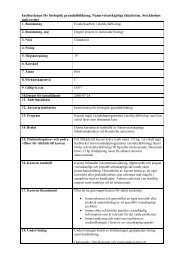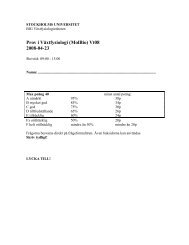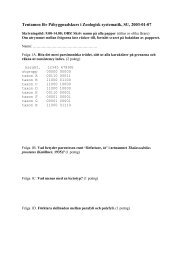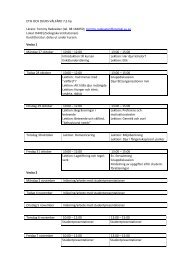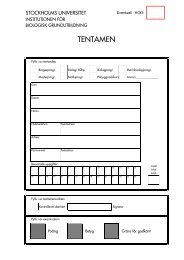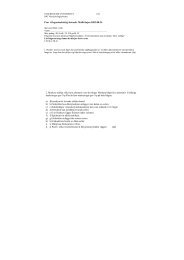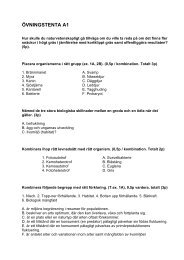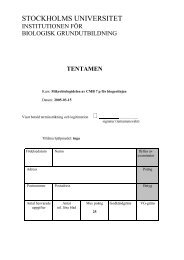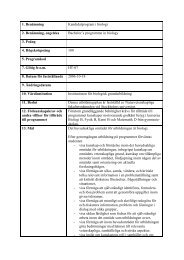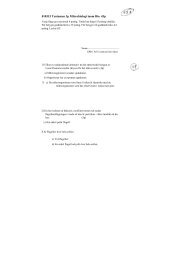Guidelines and Templates for Grading Criteria used in ... - BIG
Guidelines and Templates for Grading Criteria used in ... - BIG
Guidelines and Templates for Grading Criteria used in ... - BIG
You also want an ePaper? Increase the reach of your titles
YUMPU automatically turns print PDFs into web optimized ePapers that Google loves.
Appendix 2<br />
Template 1: <strong>Grad<strong>in</strong>g</strong> criteria <strong>for</strong> practical laboratory exercises (two-po<strong>in</strong>t grad<strong>in</strong>g scale)<br />
In order to pass the practical laboratory exercises that are part of the course, you must<br />
<strong>in</strong>dividually/<strong>in</strong> a group of size X carry out <strong>and</strong> subsequently present <strong>in</strong>dividually/<strong>in</strong> a group of<br />
size X all of/the follow<strong>in</strong>g laboratory exercises. The presentation is to be written <strong>in</strong><br />
Swedish/English <strong>and</strong> is to have the follow<strong>in</strong>g structure, unless otherwise specified.<br />
Title<br />
Introduction<br />
Describe briefly <strong>and</strong> clearly the aim of the exercise, <strong>and</strong> describe the theoretical background.<br />
Materials <strong>and</strong> methods<br />
Summarise what you have done (without simply reproduc<strong>in</strong>g large parts of the lab<br />
<strong>in</strong>structions). Specify clearly any deviations from the lab <strong>in</strong>structions. Feel free to supplement<br />
the text with figures <strong>and</strong> flow diagrams.<br />
Results<br />
Raw data is to be presented <strong>in</strong> tables such that it is easy to ga<strong>in</strong> an overview. Each table is to<br />
have a title, <strong>and</strong> it is to be clear what the rows <strong>and</strong> columns of the table present. Large<br />
quantities of raw data may be presented as an appendix. Calculations are to be presented such<br />
that each step is clear, <strong>and</strong> such that the calculation is easy to follow <strong>for</strong> the person assess<strong>in</strong>g<br />
the report. The results of the calculations are to be clearly presented. Any graphs <strong>in</strong>cluded<br />
must be attractively drawn, <strong>and</strong> the axes labelled with the correct units.<br />
Discussion<br />
Summarise <strong>and</strong> <strong>in</strong>terpret the results that have been presented <strong>in</strong> the preced<strong>in</strong>g section.<br />
Conclusions must be clearly expressed <strong>and</strong> well-supported. Answer any questions that the lab<br />
<strong>in</strong>structions pose. If the results deviate from those expected, the reasons <strong>for</strong> this must be<br />
discussed <strong>and</strong> possible sources of error must be described.<br />
References<br />
References are to be given if they lie outside of the lab <strong>in</strong>structions or the compulsory course<br />
literature.<br />
General <strong>in</strong><strong>for</strong>mation<br />
It is preferred that the report is written on a computer. If this is not the case, it must be written<br />
with tidy <strong>and</strong> easy-to-read h<strong>and</strong>writ<strong>in</strong>g. Write the report as runn<strong>in</strong>g text with complete<br />
sentences, <strong>and</strong> make every ef<strong>for</strong>t to use a clear, correct <strong>and</strong> objective language. Avoid us<strong>in</strong>g<br />
<strong>in</strong><strong>for</strong>mal language <strong>and</strong> laboratory jargon. Check the spell<strong>in</strong>g carefully! Follow the rules laid<br />
down <strong>for</strong> nomenclature (the scientific names of organisms) <strong>and</strong> other scientific term<strong>in</strong>ology<br />
(such as the names of genes <strong>and</strong> prote<strong>in</strong>s).



